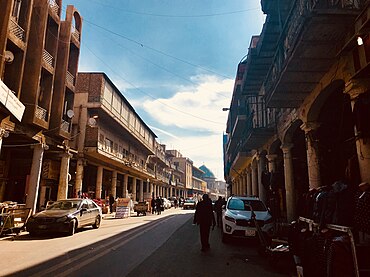 | |
| Native name | Arabic: شارع الرشيد |
|---|---|
| Former name(s) | Halil Pasha Avenue C. Hindenburg Street Al-Nasr Street |
| Part of | Old Baghdad |
| Location | Baghdad, Iraq |
| Other | |
| Known for |
|
| Status | Active |
Al-Rashid Street (Arabic: شارع الرشيد, romanized: Shari' al-Rashīd) is one of the main avenues in downtown Baghdad, Iraq. Named after Abbasid Caliph Harun al-Rashid, it is one of the most significant landmarks of the city due to its political, spiritual, urban, and cultural history. Opened from al-Maidan Square, the boulevard is considered an important urban heritage site of Baghdad and bears witness to what Iraq has gone through in terms of political events, intellectual stature, and commercial success that Iraq saw over more than a century, as well as being a tourist attraction. The avenue includes many historic landmarks such as Haydar-Khana Mosque, the Murjan Mosque, al-Zahawi Café, and Souk al-Haraj.
Historically, the street has gone by many names. Al-Rashid Street became recognized as a symbol of the transformation of Baghdad due to the many changes the city has seen through the last century. The street has been compared to various notable streets around the world such as the Champs-Élysées in Paris, the Muhammad Ali Street in Cairo, and the Hamra Street in Beirut due to their artistic, historic, and influential significance.[4] The street has also been suggested to be enlisted on UNESCO's World Heritage Site due to its history and significance and many efforts were done to get it enlisted[5] and was observed as the main historic avenue and commerce area of Baghdad in the past and its area was compared to the Rive Gauche in Paris.[6]
In recent years, the avenue has been recognized as the heart of Baghdad and nicknamed "Baghdad's living memory" due to its significance.
- ^ Caiani 2013, pp. 42–44.
- ^ Al-Qaisi 2014, p. 37.
- ^ Hann 2015, p. 147.
- ^ Al-Mutairi 2007.
- ^ Mostafa 2018.
- ^ Hann 2015, pp. 126–128.